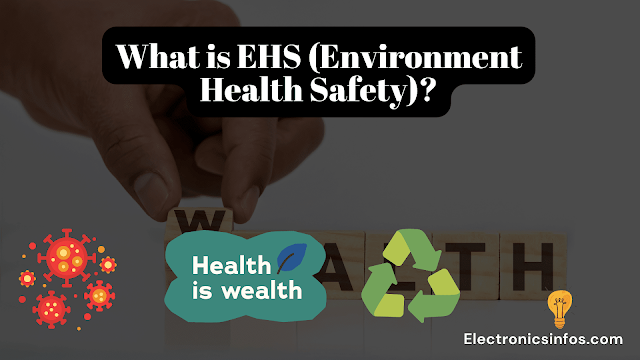What is EHS (Environment Health Safety)?
EHS stands for Environment, Health, and Safety. It is protecting the environment, promoting health, and ensuring safety. EHS is implemented in various places such as workplaces, communities, and public spaces. The primary purpose of EHS(Environment, Health Safety) is to ensure safety and reduce fatal and minor incidents.
Importance of Environment Health Safety(EHS)
Environment, Health, and Safety (EHS) is important in various industries and organizations for several reasons
- One of the primary goals of EHS is to ensure the safety of workers.
- EHS programs help prevent accidents, injuries, illnesses, and fatalities among employees.
- Compliance with environmental, health, and safety regulations and standards is a legal requirement for businesses and organizations.
- EHS programs help ensure that organizations meet regulatory requirements and maintain a safe and compliant workplace.
- EHS programs play a crucial role in risk management. Effective risk management reduces the likelihood of incidents, minimizes operational disruptions, and protects organizational assets.
- EHS programs focus on environmental protection by promoting sustainable practices.
- Investing in EHS initiatives can result in cost savings for organizations. By preventing accidents, injuries, and illnesses.
Advantages of EHS(Environment Health Safety)
There are several advantages to implementing effective Environment, Health, and Safety (EHS) practices within an organization. These advantages include
- Enhanced Employee Safety
- Improved Compliance
- Reduced Costs
- Enhanced Reputation
- Increased Productivity
- Environmental Protection
- Risk Mitigation
- Legal and Ethical Responsibilities
Enhanced Employee Safety
Enhancing employee safety requires proactive measures and a focus on employee well-being. Employers should provide regular safety training to educate employees about potential hazards and emergency procedures. Conducting risk assessments helps identify and prioritize safety measures. Clear safety policies and procedures should be established and easily accessible to all employees. Appropriate safety equipment and tools, along with regular equipment maintenance, are essential.
Emergency preparedness plans
Emergency preparedness plans and regular drills ensure employees know how to respond in critical situations. Encouraging safety reporting and investigation helps identify and address risks promptly. Ergonomic considerations and mental health support contribute to overall employee well-being. Continuous improvement based on feedback and analysis is vital for ongoing safety enhancements. By prioritizing employee safety, employers can create a productive and positive work environment.
Improved Compliance
Improved compliance is essential for maintaining a safe and ethical work environment. Employers should establish clear policies and procedures that align with relevant laws, regulations, and industry standards. Regular training and communication should be provided to employees to ensure they understand their obligations and responsibilities. Implementing robust monitoring and reporting systems can help identify and address compliance issues promptly.
Regular monitoring
It is essential to conduct regular audits and inspections to assess compliance levels and identify areas for improvement. By fostering a culture of compliance and providing the necessary resources and support, employers can enhance adherence to regulations, mitigate risks, and safeguard the well-being of employees and the organization as a whole.
Reduced Costs
Implementing effective cost-reduction measures is crucial for organizational success and sustainability. One area where significant savings can be achieved is through a focus on employee safety. By prioritizing safety, employers can reduce the frequency and severity of workplace accidents and injuries, which can result in decreased medical costs, workers' compensation claims, and insurance premiums. Investing in safety training, equipment, and maintenance may entail upfront expenses but can lead to long-term cost savings.
Enhanced Reputation
Building and maintaining a strong reputation is essential for the success and growth of any organization. Prioritizing employee safety can significantly contribute to enhancing reputation. When employers demonstrate a commitment to creating a safe work environment, it sends a positive message to stakeholders, including employees, customers, suppliers, and the public.
A strong safety record showcases the organization's values, professionalism, and dedication to the well-being of its employees. This can lead to increased trust, improved brand image, and a competitive advantage in the marketplace.
Increased Productivity
Enhancing employee safety can have a direct impact on productivity within an organization. When employees feel safe and secure in their work environment, they are more likely to focus on their tasks and perform at their best. A safe workplace reduces the occurrence of accidents and injuries, which can result in decreased absenteeism and downtime due to employee health issues. Furthermore, employees who are confident in their safety are more engaged and motivated, leading to improved job satisfaction and higher levels of productivity.
Environmental Protection
Environmental protection is a critical responsibility for organizations aiming to operate sustainably and mitigate their impact on the planet. Implementing environmentally friendly practices not only demonstrates corporate social responsibility but also contributes to a positive reputation and long-term viability. Employers can prioritize environmental protection by adopting energy-efficient technologies, reducing waste generation, and promoting recycling and resource conservation.
Risk Mitigation
Risk mitigation is a fundamental aspect of managing any organization and ensuring its long-term success. By implementing robust risk management strategies, organizations can identify and address potential threats and vulnerabilities proactively. This includes conducting comprehensive risk assessments to identify and evaluate risks across various areas such as operations, finance, legal compliance, reputation, and cybersecurity. Once risks are identified, appropriate controls and mitigation measures can be implemented to minimize the likelihood and impact of adverse events.
Legal and Ethical Responsibilities
Legal and ethical responsibilities are essential aspects of running a responsible organization. Companies have a legal obligation to comply with relevant laws, regulations, and industry standards in all areas of operation. This includes adherence to labour laws, workplace safety regulations, environmental protection guidelines, and consumer protection laws, among others. Organizations must also prioritize ethical responsibilities by operating with integrity, fairness, and transparency.


.png)



0 Comments
please do not insert spam links